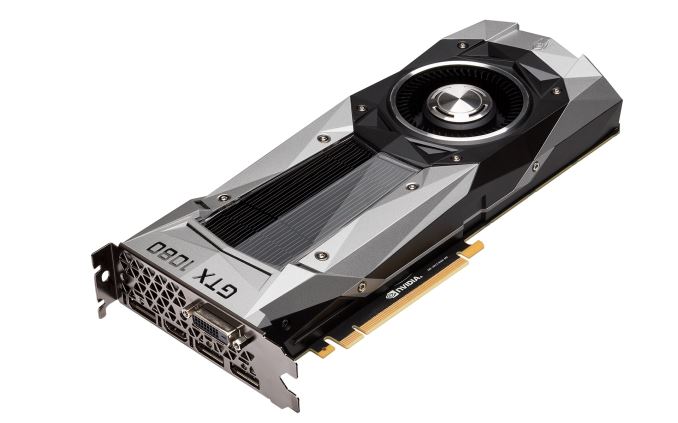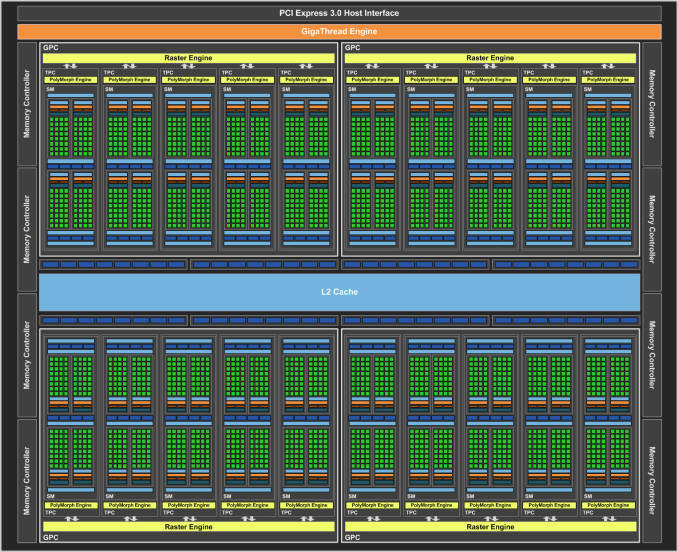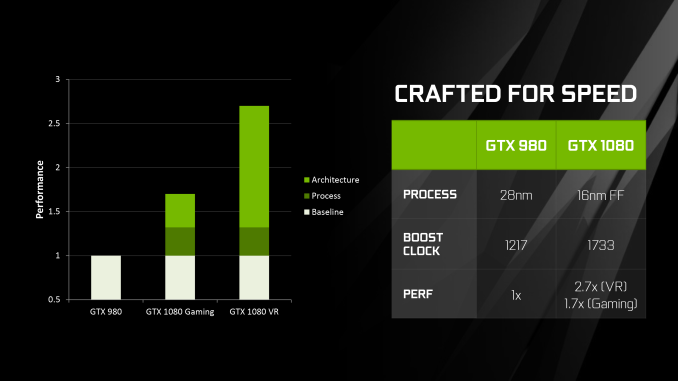The NVIDIA GeForce GTX 1080 Preview: A Look at What's to Come
by Ryan Smith on May 17, 2016 9:00 AM EST
Earlier this month NVIDIA announced their latest generation flagship GeForce card, the GeForce GTX 1080. Based on their new Pascal architecture and built on TSMC’s 16nm FinFET process, the GTX 1080 is being launched as the first 16nm/14nm-based video card, and in time-honored fashion NVIDIA is starting at the high-end. The end result is that the GTX 1080 will be setting the new high mark for single-GPU performance.
Unlike past launches, NVIDIA is stretching out the launch of the GTX 1080 a bit more. After previously announcing it back on May 6th, the company is lifting their performance and architecture embargo today. Gamers however won’t be able to get their hands on the card until the 27th – next Friday – with pre-order sales starting this Friday. It is virtually guaranteed that the first batch of cards will sell out, but potential buyers will have a few days to mull over the data and decide if they want to throw down $699 for one of the first Founders Edition cards.
As for the AnandTech review, as I’ve only had a few days to work on the article, I’m going to hold it back rather than rush it out as a less thorough article. In the meantime however, as I know everyone is eager to see our take on performance, I wanted to take a quick look at the card and the numbers as a preview of what’s to come. Furthermore the entire performance dataset has been made available in the new GPU 2016 section of AnandTech Bench, for anyone who wants to see results at additional resolutions and settings.
Architecture
| NVIDIA GPU Specification Comparison | ||||||
| GTX 1080 | GTX 980 Ti | GTX 980 | GTX 780 | |||
| CUDA Cores | 2560 | 2816 | 2048 | 2304 | ||
| Texture Units | 160 | 176 | 128 | 192 | ||
| ROPs | 64 | 96 | 64 | 48 | ||
| Core Clock | 1607MHz | 1000MHz | 1126MHz | 863MHz | ||
| Boost Clock | 1733MHz | 1075MHz | 1216MHz | 900Mhz | ||
| TFLOPs (FMA) | 9 TFLOPs | 6 TFLOPs | 5 TFLOPs | 4.1 TFLOPs | ||
| Memory Clock | 10Gbps GDDR5X | 7Gbps GDDR5 | 7Gbps GDDR5 | 6Gbps GDDR5 | ||
| Memory Bus Width | 256-bit | 384-bit | 256-bit | 384-bit | ||
| VRAM | 8GB | 6GB | 4GB | 3GB | ||
| FP64 | 1/32 | 1/32 | 1/32 FP32 | 1/24 FP32 | ||
| TDP | 180W | 250W | 165W | 250W | ||
| GPU | GP104 | GM200 | GM204 | GK110 | ||
| Transistor Count | 7.2B | 8B | 5.2B | 7.1B | ||
| Manufacturing Process | TSMC 16nm | TSMC 28nm | TSMC 28nm | TSMC 28nm | ||
| Launch Date | 05/27/2016 | 06/01/2015 | 09/18/2014 | 05/23/2013 | ||
| Launch Price | MSRP: $599 Founders $699 |
$649 | $549 | $649 | ||
While I’ll get into architecture in much greater detail in the full article, at a high level the Pascal architecture (as implemented in GP104) is a mix of old and new; it’s not a revolution, but it’s an important refinement. Maxwell as an architecture was very successful for NVIDIA both at the consumer level and the professional level, and for the consumer iterations of Pascal, NVIDIA has not made any radical changes. The basic throughput of the architecture has not changed – the ALUs, texture units, ROPs, and caches all perform similar to how they did in GM2xx.
Consequently the performance aspects of consumer Pascal – we’ll ignore GP100 for the moment – are pretty easy to understand. NVIDIA’s focus on this generation has been on pouring on the clockspeed to push total compute throughput to 9 TFLOPs, and updating their memory subsystem to feed the beast that is GP104.
On the clockspeed front, a great deal of the gains come from the move to 16nm FinFET. The smaller process allows NVIDIA to design a 7.2B transistor chip at just 314mm2, while the use of FinFET transistors, though ultimately outright necessary for a process this small to avoid debilitating leakage, has a significant benefit to power consumption and the clockspeeds NVIDIA can get away with at practical levels of power consumption. To that end NVIDIA has sort of run with the idea of boosting clockspeeds, and relative to Maxwell they have done additional work at the chip design level to allow for higher clockspeeds at the necessary critical paths. All of this is coupled with energy efficiency optimizations at both the process and architectural level, in order to allow NVIDIA to hit these clockspeeds without blowing GTX 1080’s power budget.
Meanwhile to feed GTX 1080, NVIDIA has made a pair of important changes to improve their effective memory bandwidth. The first of these is the inclusion of faster GDDR5X memory, which as implemented on GTX 1080 is capable of reaching 10Gb/sec/pin, a significant 43% jump in theoretical bandwidth over the 7Gb/sec/pin speeds offered by traditional GDDR5 on last-generation Maxwell products. Coupled with this is the latest iteration of NVIDIA’s delta color compression technology – now on its fourth generation – which sees NVIDIA once again expanding their pattern library to better compress frame buffers and render targets. NVIDIA’s figures put the effective memory bandwidth gain at 20%, or a roughly 17% reduction in memory bandwidth used thanks to the newer compression methods.
As for features included, we’ll touch upon that in a lot more detail in the full review. But while Pascal is not a massive overhaul of NVIDIA’s architecture, it’s not without its own feature additions. Pascal gains the ability to pre-empt graphics operations at the pixel (thread) level and compute operations at the instruction level, allowing for much faster context switching. And on the graphics side of matters, the architecture introduces a new geometry projection ability – Simultaneous Multi-Projection – and as a more minor update, gets bumped up to Conservative Rasterization Tier 2.
Looking at the raw specifications then, GTX 1080 does not disappoint. Though we’re looking at fewer CUDA cores than the GM200 based GTX 980 Ti or Titan, NVIDIA’s significant focus on clockspeed means that GP104’s 2560 CUDA cores are far more performant than a simple core count would suggest. The base clockspeed of 1607MHz is some 42% higher than GTX 980 (and 60% higher than GTX 980 Ti), and the 1733MHz boost clockspeed is a similar gain. On paper, GTX 1080 is set to offer 78% better performance than GTX 980, and 47% better performance than GTX 980 Ti. The real world gains are, of course, not quite this great, but they’re also relatively close to these numbers at times.















262 Comments
View All Comments
bill44 - Wednesday, May 18, 2016 - link
That's a bummer.Currently, I have 3x screens connected. 2x desktop monitors and 1x for HTPC trough the amp.
If I wanted full hardware HEVC 10bit decoding, DP1.3/1.4 for 2x 4K or 5K HDR monitor over 1x cable, I need to give up 10bpc support for windowed apps. Or, go with something like the quadro M2000 with non of the latest goodies (DP 1.2, HDMI 2.0b, full HW decode HEVC 10bit, HDR etc. etc.).
It will be quite a while before any new quadro support them. Regardless of price.
Ryan Smith - Wednesday, May 18, 2016 - link
To be clear, you get 10bpc support for windowed D3D applications, so your HTPC idea will work.The distinction is for professional applications such as Photoshop. NVIDIA has artificially restricted 10bpc color support for those applications in order to make it a Quadro feature, and that doesn't change for GTX 1080.
sagman12 - Tuesday, May 17, 2016 - link
"Gamers however won’t be able to get their hands on the card until the 27th – next Friday – with pre-order sales starting this Friday." I hope this is true. I don't want to have to stay up all day hitting F5 until i secure my 1080FER3MF - Tuesday, May 17, 2016 - link
Looking at an unopened Gigabyte R9 390X G1 that I picked up for £250 (standard price for an R9 390X is £330-£360 in UK money).
This is getting 50-66 percent of the framerate of the GTX 1080, but for slightly less than half the price ($599 for the non-Founders edition translates to roughly £500 inc VAT).
Knowing what we know no about likely performance of upcoming 14/16nm products, should i be sending it back?
cheshirster - Tuesday, May 17, 2016 - link
Perf/$ would not change drastically.But perf/watt will skyrocket. You probably will be able to get the same perf in half the power.
R3MF - Tuesday, May 17, 2016 - link
cheersMarucins - Tuesday, May 17, 2016 - link
Where is COMPUTING tests?3ogdy - Tuesday, May 17, 2016 - link
Ryan, please consider integrating this in your upcoming review of the 1080. It would be extremely useful:Clock the 1080 just like the 980 and then compare their performance. I would like to see how much of that 15-FPS-on-avg increase vs 980Ti comes from clock speed increase and how much of an impact does Pascal actually have. As it looks right now, the 1080 is a disappointement - I was expecting something truly stellar from nVidia after touting this and that and making serious all-around changes , taking advantage of a process node half as big as the previous one...so far 1080 is shaping to be just an incremental upgrade if not even a sidegrade when clock speed differences are negated. I hope I'm as wrong as one could be, though. Good preview so far!
tarqsharq - Tuesday, May 17, 2016 - link
Yes, this would be very interesting!genekellyjr - Tuesday, May 17, 2016 - link
Doing some quick calcs w/ BF4 FPS numbers gives 1080 - 111 FPS/MHz/core, 980Ti - 150 FPS/MHz/core, 980 - 75 FPS/MHz/core for 4K. The 1440p and 1080p numbers also follow suit (150/206/102 for 1440p, 231/319/159 for 1080p).Essentially, doing meaningless number crunching does show that normalized the 980Ti is better per MHz per core, at least for BF4. I used the boost clock numbers for the MHz. Hope it is investigated because it seems like Nvidia spent extra transistor bank on other aspects significantly (maybe F16 compute?) to the detriment of their F32 gaming chops.